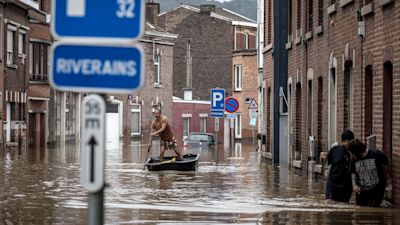Climate change: Six things we learned from the UN's stark report

These are the human stories behind the UN's landmark science report, ITV News Deputy Political Editor Anushka Asthana reports
A UN report into the climate crisis sets out a starkly bleak picture of the future of the planet if the world does not act soon - and quickly.
The report provide the clearest picture yet of the effect of human activities on the climate and on weather extremes that we are all ready seeing across the globe - from the heat dome in Canada to flash flooding in Germany to wildfires in Greece . Human behaviour will make heatwaves, heavy precipitation, droughts and tropical cyclones increasingly commonplace.
It presents the first clear evidence of the links between human influence and more intense heatwaves and rainstorms.
Here are some of its key findings.
There is no doubt the climate crisis is driven by human activity
The UN report said was “unequivocal” that humans were behind the climate emergency. Activities such as burning fossil fuels and methane production have warmed the atmosphere, ocean and land causing widespread and rapid changes across the world. The report clearly says these changes are unprecedented for many centuries or even many thousands of years. Humans are also very likely to be behind the global retreat of glaciers, decline in sea ice, warming oceans and rising sea levels.
Carbon dioxide and methane levels are highest in three million years
CO2 levels in the atmosphere are higher than they have been for three million years while the report sounded a new warning on the dangers of rising methane concentrations . Levels of methane - a relatively short-lived but potent greenhouse gas cased by oil and gas drilling and agriculture – are higher than they have been for 800,000 years, with rises in both greenhouse gases well above natural changes seen for hundreds of thousands of years.
Greenhouse gases are well above natural changes seen for hundreds of thousands of years.
The world is getting hotter
In the last decade, average global temperatures are nearly 1.1C higher than in pre-industrial times, or the period 1850-1900, driven by emissions caused by burning fossil fuels and deforestation.
While 1C does not sound like a lot, every additional increment of warming causes larger changes in extremes. Every extra 0.5C temperature rises leads to clear increases in the intensity of heatwaves, heavy rain that can cause flooding, and droughts.
The current impact of climate change is already being felt and this will worsen with even 1.5C of warming - further temperature increases will have an even greater impact in many areas.
The world is currently on a pathway that could lead to 2.7C of warming by the late 21st century – or higher if the pledges were not delivered on - scientists who worked on the report warned.
Sea levels would rise by around 28-55cm (11-22 inches) by 2100 in a very low emissions scenario, but by significantly more if emissions stayed high.
Higher emissions would increase the number of coastal areas that would see once-in-a-century coastal flooding and storm surge events happen every year.
Strong, rapid and sustained reductions in emissions of methane would help curb warming, and would also improve air quality, the report said.
The effects of global warming are already here.
The report made it clear that human-caused climate change is behind some of the extreme weather events we have seen in the last year, such as the flooding in Germany in July and the intense wildfires in Greece.And things will get worse. Hot extremes, marine heatwaves, heavy rain, droughts in some regions will become more frequent and intense. Human-cause global warming will also cause the proportion of intense tropical cyclones while Arctic sea ice, snow cover and permafrost will reduce.
Some changes may already be irreversible
Changes to oceans, sea levels and melting permafrost and glaciers are irreversible for decades, centuries or even millennia as a result of past and future warming, the report said.
Ocean and land carbon sinks - that is anything that absorbs more carbon from the atmosphere than it releases - are projected to become less effective at slowing the accumulation of the greenhouse gas in the atmosphere as the damage becomes worse.
We are not doomed if the world does breach the 1.5C target
Scientists involved in the report are clear that the 1.5C or 2C thresholds are not cliff edges that the world will fall off.
As Prof Richard Betts, from the Met Office Hadley Centre and a contributing author to the report, puts it: “Like the speed limit on a motorway, staying below it is not perfectly safe and exceeding it does not immediately lead to calamity, but the risks do increase if the limit is passed.
“Limiting warming to 1.5C clearly needs much more urgent emissions cuts than is currently happening, but if the target is still breached we should not assume all is lost and give up – it will still be worth continuing action on emissions reductions to avoid even more warming.”
What are the key findings from the UN climate change report?